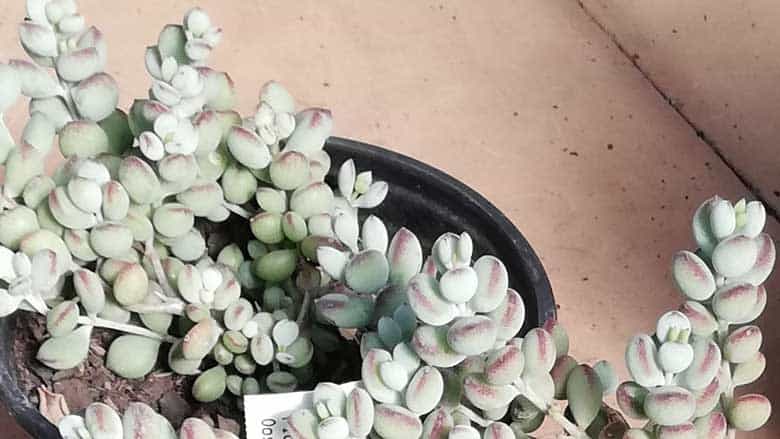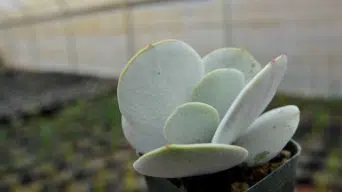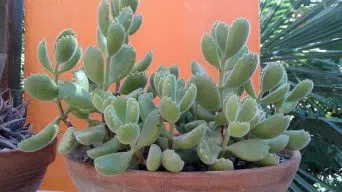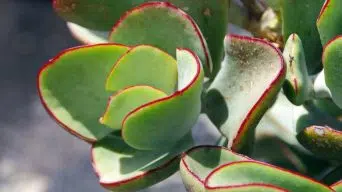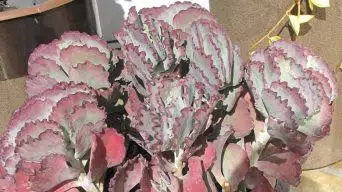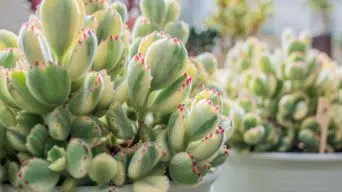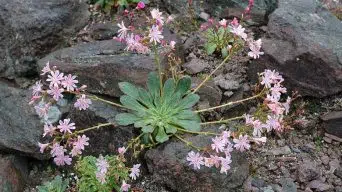Cotyledon Pendens is a beautiful and unusual species of succulent plant with an elegant dangling pendant.
It can be found in the wild and cultivation, though it is not commonly seen due to its rarity.
The cotyledons (the first leaves) are green and pointed while the rest of the leaf grows longer and turns into a red-brown color.
Cotyledon Pendens care includes keeping them indoors during winter months or placing them outside. They will receive plenty of sunlight but must be protected from frost.
This guide will help you properly propagate and care for your Cotyledon Pendens, helping it thrive and grow to its full potential.
About the Cotyledon Pendens Plant
Cotyledon Pendens is a succulent plant, also known as ‘Cliff Cotyledon’. These plants are native to South Africa and Namibia. They grow on rocky outcrops in the summer months but spend their winters dormant in cracks and crevices within these rocks.
The Cliff Cotyledon Pendens plant has a fleshy green, bulbous stem that can grow up to 18 inches tall.
The plant will usually produce one or two large leaves along this stem. These leaves are around 28-inches long and have parallel lobes with serrated edges on their margins.
The Cotyledon Pendens succulent has an interesting shape because it appears as if the “pendant” portion of its name refers to how the heavy leaf droops from the top of each stalk.
How To Care for Cotyledon Pendens (Cliff Cotyledon)
Sun Exposure & Light Requirements
The Cotyledon Pendens needs good bright light, but it does not need to be in direct sunlight. The plant will grow well with indirect sun exposure from an east or west-facing window.
The ideal location would have bright but filtered light conditions, as long as this still allows air movement through the leaves when spraying them with water.
This succulent requires six hours of full sun each day if growing outdoors (but can tolerate less without problems). Just make sure your pot gets enough natural light before placing it outside!
When placed indoors next to a sunny window, the Cotyledon Pendens will need to be rotated every few days so that all sides of the plant receive light.
If you are growing this succulent as a houseplant and it is in low-light conditions, you should consider using an artificial grow light (such as CFLs) for around 12 hours per day or more if needed.
The only time when too much indirect sun exposure may cause problems is during winter. This is because plants grown outside won’t get enough natural sunlight due to changes in daylight duration (and thus length).
Watering Requirements
The Cotyledon Pendens succulent plant is a drought-tolerant species that can thrive under arid conditions.
However, it’s still essential to provide the right amount of water for this plant to promote healthy growth and prevent root rot.
It should be watered with a fine spray or with the use of a garden hose. When watering, it’s important to avoid splashing soil on the leaves because this can cause damage and dull its coloring.
The Cotyledon Pendens plant should be watered when the topsoil feels dry up to one inch deep.
Watering frequency should depend on soil type; more clayey soils will require less frequent watering than sandy or loamy soils.
A good way of determining if your cotyledons are thirsty is by giving them just enough water that you see some moisture accumulating at their base after fifteen minutes (don’t wait too long).
It’s also recommended not to let plants sit in standing pots for more than two weeks without being watered.
The best time for watering Cotyledon Pendens succulents is midmorning since they need less water during hot midday hours.
Soil Requirements
Cotyledon Pendens plants need to be planted in soil that is well-draining and porous.
Some of the best soils for this type are cactus or succulent potting mix, perlite, pumice, sandstone gravels (lava rock), or bark mulch.
The perfect soil has organic matter mixed with it. Organic matter doesn’t dry the soil out quickly, but make sure you don’t use weed killers or fertilizers that will kill the Cotyledons!
The soil should be well watered before planting and again every time the top inch or so has dried.
The plant can also be grown in a hanging pot, making watering easier to do by hand when needed.
Cotyledon Pendens do NOT like wet feet, and damp soils around them will cause rot, making for unhappy plants!
Temperature and Humidity
The Cotyledon Pendens need to be in temperatures of 55-90 degrees Fahrenheit and a humidity level that is 60%-80%. This means they are not tolerant to drafts or cold.
They need indirect light, so the sunlight does not burn them but still gives them enough energy for photosynthesis.
With this environment, you can grow your cotyledons outside during the summer months, after frost danger has passed until the first frost warning comes in.
If you live in an area that has cold winters, they should be kept inside.
The Cotyledon Pendens succulent plant does not like high humidity levels at all; this could lead to rot or mold on the leaves of your plants.
If you live in an area with wet seasons, make sure that you provide enough drainage. Also, keep away from drafts when keeping them inside because this can cause the leaves to turn yellow and fall off.
Fertilizing
Fertilizing is not required for the Cotyledon Pendens. However, if you want to fertilize it, I recommend using a fertilizer made for cacti and other succulents.
Do not use any type of food or human fertilizer on this plant because they may cause the leaf tips to burn and turn brown.
- Place one tablespoon per gallon of water in your container once every three months.
- Use an organic liquid feed with low nitrogen content, such as those containing fish emulsion (Fertilizer), once every three weeks.
- Apply fertilizer sparingly so it does not come into contact with the cotyledon ovaries or new leaves.
The best time to fertilize your Cotyledon Pendens is when new growth begins in the spring.
It’s also a good idea to fertilize your plants after they have had a repotting, which you should do as needed.
Repotting
One of the most overlooked aspects of Cotyledon Pendens care is potting and repotting.
It can be tempting to leave your plant in its original pot, but you should consider changing it at least once per year. It is indispensable when the soil becomes too compact or has become mixed with bacteria, leading to root rot.
A good time to start thinking about a new container would be when you notice roots poking out from the drainage hole in the bottom of an old planter.
When transferring a Cotyledon Pendens succulent from one container to another, make sure to gently remove as much of the old soil from around its roots.
Then fill the new container with fresh soil and tamp it down.
You can fertilize your Cotyledon Pendens after repotting, but be aware that too much fertilizer will cause an overgrowth of algae or moss on its leaves.
The best time to transplant Cotyledon Pendens plants is winter (December-February). This allows enough time before the summer heat begins for the roots to heal and adjust to their new surroundings.
Pruning Cotyledon Pendens Succulent
Pruning the Cotyledon Pendens succulent plant has many benefits, which is why it should be done periodically.
First, when you trim off some of the shoots on your Cotyledon plants at intervals apart from each other (every six months).
This will make more branches and leaves grow. This is because there will be less competition for water and nutrients between the remaining stems.
A second way to make new branches is to cut off the terminal bud near the top or just below it as soon as it appears.
This forces the plant to grow new buds that will eventually become twigs, which have a more significant number of roots than if left unpruned.
You can grow the Cotyledon Pendens plant by cutting it back to just one or two branches at a time. It will make each branch grow better and also make more leaves.s.
It’s best not to prune your Cotyledon plants during wintertime because any growths that form after this period could be damaged due to cold weather.
Finally, wait until the spring when the shoots are stronger. This will give them time to recover after periods of stress so they can grow flowers with energy in the summer.
Pests and Diseases
Cotyledon Pendens are not susceptible to many pests or diseases.
Pests
The most common pest is the mealybug, which can be difficult if left unchecked for a long time.
They feed on the plant by sucking out the sap, so they must be removed immediately.
The easiest way to get rid of them is with an insecticide soap spray or neem oil.
There are also cactus and heavy oils that will smother mealybugs if applied directly onto their body (do not apply these near other plants).
You can also use a cotton swab dipped in alcohol, which suffocates them.
Diseases
The most common disease that Cotyledon Pendens are susceptible to is Cotyledon rot.
This happens when there is too much water, and the plant’s roots start to decay.
It can be treated by cutting away all damaged tissue around the base of the rotted area, cleaning off any contaminated soil or attached material.
A thorough rinse should follow that and then an application of cactus fertilizer.
The plant will need time to heal, but it can usually recover from this disease if given the proper care.
How To Propagate Cotyledon Pendens (Cliff Cotyledon)
This plant is an easy succulent to grow and propagate but does require a bit of patience.
Offsets
The Cotyledon Pendens can be propagated in several different ways. Still, the most common methods are by removing offsets from the base or stem and planting them in cacti soil. The roots will form on their own if given time.
- Take an offset of the root clustered base with your fingers
- Remove any old leaves that may be compromising water retention
- Soak it for 15 minutes before planting to aid in seedling emergence
- Plant rooted offsets about two inches deep and keep at least one inch between each plantlet (If planted too close together, they can hinder growth)
- Allow to dry before watering
- Water on a weekly basis (more if in extreme drought)
- If the temperature exceeds 85 degrees, be sure to water with nutrient-enriched water or allow for more time between each watering.
Cuttings
Growing cuttings is an easy method that can be done at any stage of growth and will result in some variation of plant form.
The most common way this is propagated is by using rooted cuttings taken from the lower stem instead of offsets found closer to the base.
Given space restrictions, this gives you more control over the number of plants. It also allows for easier propagation as offset plants don’t require waiting to mature.
- Cut a stem from the lower section of the plant
- Slice off all but four leaves at the end near where you cut it, and remove any flower stalks. (This ensures that your cutting has enough water when starting out)
- Make sure not to damage any part of the Cotyledon Pendens root system on either side, as this will make for an unsuccessful propagation attempt.
- Place in a well-draining soil mix with full sun exposure or grow lights indoors
The most common time for success is between November through March. Its native habitat and temperate weather conditions are changing during those months.
It might be necessary to reposition plants inside if left outside in colder temperatures due to frost.
Is the Cotyledon Pendens Toxic?
The Cotyledon Pendens is toxic to dogs. Unfortunately, it is also poisonous to cats and rabbits, so it should always be kept away from these animals.
Dogs can become very ill after ingesting this succulent plant because of the neurotoxins found in its leaves.
They might experience vomiting or diarrhea and muscle tremors, and seizures if a lot of the plant was eaten at one time.
The toxins are carried through their bloodstreams, poisoning other organs like their heart, lungs, kidneys, and liver.
Cats have an extremely low tolerance for poisonings with Cotyledon Pendens plants since they do not vomit up what they eat – which would otherwise protect them against accidental ingestion of neurotoxins.
Rabbits have a high tolerance to the toxins found in Cotyledon Pendens plants. However, they can still become ill after ingesting too much of this succulent plant or if it is eaten over time.
Final Thoughts
The Cotyledon Pendens succulent plant is a beautiful and popular choice for any succulent enthusiast.
This succulent is among the most straightforward to propagate and exhibits a relatively rapid growth rate. In addition, its pleasant colors make it perfect for just about any setting.
The Cotyledon Pendens succulent plant doesn’t need much care. It is an easy way for beginners to get involved in propagating plants.

